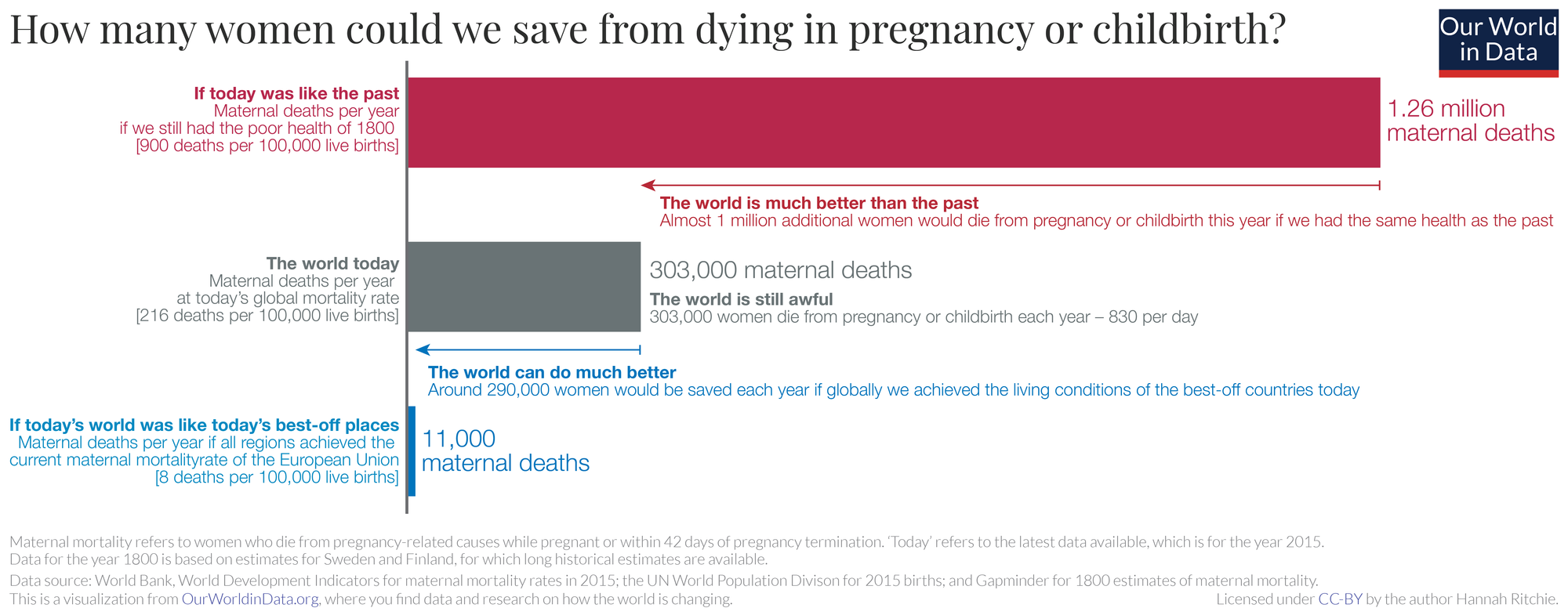Progress in maternal mortality saves the lives of nearly 1 million mothers a year, every year

The wealthier a country is, the healthier it is. Variation in income can explain over seventy per cent of the variation in infant and child mortality. No country with an income per capita above $10,000 has an infant mortality rate above two percent.” — Progress, Ten Reasons to Look Forward to the Future, Johan Norberg
When my eldest son was ten months old, he experienced a urinary tract infection (UTI), which was unusual for a young boy but didn’t necessarily raise the alarm. Our general practitioner provided a script for a course of antibiotics, which, over the coming week, helped to clear the infection. Unfortunately, two days after finishing the prescription, the infection returned, but this time the speed and virulence of the infection were frightening. That evening, our son collapsed at the table, and I remember lifting his limp, silent body from the chair and carrying him to the car, as I rushed my wife and child to the emergency room. At that point, our young boy would have been a statistic at the dawn of the 19th century, one of the 40 percent of children globally who didn’t live past their fifth birthday, dying largely of preventable disease, infection, malnutrition, starvation, or injury.
However, mercifully, that wasn’t our experience. If you want to see an emergency room shift into immediate action, carry in a limp and unresponsive young child. In the 12 hours between his arrival in hospital and the following morning, the doctors ran tests, completed an ultrasound, and provided a large dose of life-saving antibiotics. That immediate and effective medical care took a child trending toward death by septic shock and saved his life.
Sadly, for nearly all of human history, mothers lost their children and, all too often, their own lives during childbirth. Even if they survived birth, children faced an uphill battle making it through the first few years of life; to quote Bill Bryson, “The world before the modern era was overwhelmingly a place of tiny coffins.” For thousands of years prior to the Industrial Revolution, global child and under-15 mortality ranged between 49 and 40 percent, with the loss of every child undoubtedly a painful family tragedy. The world prior to globalization and widespread economic growth was a hungry, dirty, sick, impoverished, ignorant, and violent environment in which to try and eke out your survival in those first fragile years of life.
Even in the wealthiest countries in pre-industrial Europe, mothers would expect to suffer the loss of at least three in ten children on average, but many suffered double that figure. By the middle of the 19th century, the best-performing countries — Norway, Sweden, Denmark, and Belgium — saw 169 to 258 children under the age of five die per 1,000 live births, while the rate in China, India, and Bangladesh was 417, 509, and 508, respectively.
The story was little better for mothers, who experienced high rates of maternal mortality during and shortly after pregnancy and birth. Seriously obstructed births and post-birth bleeding and infection had no highly effective treatments during the 19th century; the result was a loss of 548 mothers per 100,000 live births in the United Kingdom in 1850. Even as late as 1930, the United States maternal mortality rate was 673 per 100,000 live births. When complications during birth were significant, doctors and families were faced with the heartbreaking choice to attempt to save the mother or child, but too rarely both.
Beginning in the early 20th century, childhood and maternal mortality rates, which had remained painfully high for centuries, began a steady decline in lockstep with global economic growth. The world’s most prosperous countries, those with GDP per capita of $4,000 to $10,000+, were the first to experience measurably significant and lasting reductions in mortality. Moreover, beginning in 1900, the price of progress began falling as well; that is to say, GDP per capita started helping provide lower child and maternal mortality for every dollar. Travel back to the dawn of the 20th century, and it took between $2,660 and $7,930 (GDP per capita, PPP$ inflation-adjusted), to buy a child mortality rate under 20 percent. Over the following 50 years, the GDP per capita cost of achieving a child mortality rate under 20 percent fell to as low as $958 in Romania, and more commonly between $2,000 to $5,000 GDP per capita.
Statistics aside, the cost reduction in child mortality allowed more mothers in low and middle-income countries to dramatically increase the odds of keeping their children alive into adulthood. By the end of 2022, no country globally had a child mortality rate above 11.2 percent, which is currently the world’s highest rate for children living in Somalia. That same $2,000 to $5,000 in GDP per capita that provided families with an under 20 percent child mortality rate in 1950, now buys a mortality rate of 4 percent in Uganda, and 2.5 percent in Bangladesh, with the global average at roughly 3.8 percent. Similar progress has been made in reducing maternal mortality, and where some 673 mothers died within the first 42 days in the United States for every 100,000 live births in 1930; today, that ratio has fallen to just 24 lives lost per 100,000. Globally, the number of maternal deaths in the nearly two decades spanning 2000-2017 fell from >450,000 annually to roughly 294,000; still far too many, but unquestionably progress in the right direction.
"Almost 1 million additional women would die from pregnancy or childbirth this year if we had the same health as the past." — Maternal Mortality, Max Roser and Hannah Ritchie, Our World in Data

The global economic growth and globalization that began in the 1950s kicked off the sharpest decline in child and maternal mortality in human history. As family incomes climbed, they were able to afford better shelter, health care and nutrition, clean water, and cleaner heating and cooking fuels, dramatically reducing a major cause of the indoor air pollution that ravages the lungs of young children. As counties increased GDP at a national level, governments were able to provide their citizen’s improved healthcare, water, waste removal, and sanitary wastewater treatment. These forces combined to push down maternal and child mortality in every country on earth, albeit to varying degrees. The results have been anything but trivial, and child mortality is lower today in China, India, Egypt, Algeria, and Libya than it was in the United States, United Kingdom, or France in 1950.
While global economic growth has lifted hundreds of millions from poverty over the last hundred years and, in doing so, dramatically reduced childhood and maternal mortality, there remains considerable room for further progress. Families living in Nigeria, Chad, Somalia, and the Central African Republic are all suffering from child mortality rates exceeding 10 percent, roughly where the United States was in the year 1928.
While the situation still feels grim for approximately half the world with child mortality rates above 5 percent, the good news is that reducing child and maternal mortality requires no further scientific or technological breakthroughs. The forces at work which have pushed down maternal and child mortality, saving the lives of millions of mothers and children over the last century, remain at work today. Globalization, trade, economic growth, innovation, and sound institutions and governance are the most efficient and effective macro tools we have to keep mothers alive through pregnancy, birth, and post-birth recovery, and their children alive long enough to grow into healthy adults.
A near-term future where Nigerian and Somalian mothers can expect child mortality rates as low as Australia (0.4%) or Germany (0.2%) is possible, and one we should be collectively working toward by reducing or eliminating barriers to individual and global flourishing.
This article was published at The Archbridge Institute and Profectus Magazine on 14/05/2023





